
The Basics:
- For ages 8 and up (publisher suggests 10+)
- For 2 to 4 players
- Approximately 20 minutes to complete
Geek Skills:
- Counting & Math
- Logical & Critical Decision Making
- Strategy & Tactics
- Hand/Resource Management
Learning Curve:
- Child – Easy
- Adult – Easy
Theme & Narrative:
- Compete against other horrific monsters to be the top chef!
Endorsements:
- Gamer Geek rejected!
- Parent Geek approved!
- Child Geek approved!
Overview
The Japanese television show, Iron Chef, fused together the art of culinary cuisine and flamboyant theatrics. The end result was a competition that mixed food and creativity. The winner was the chef who could cook the fastest and the best. The same applies in this game. To be the best monster chef, you need to be handy in and out of the kitchen.
Monster Chef, designed by Daniele Mazzoni and published by Believe In Games, is comprised of 12 Ingredient cards (9 simple, 3 special), 25 Recipe cards, 3 Table cards, 8 Monster Chef cards, 5 Monster Rage cards, 60 Serving tokens (15 per player), 4 Reputation cards, 3 Aid cards, and 1 standard six-sided die. The game comes with 2 expansions, thus the large number of components. The illustrations by Nicolas Aguirre Dobernack and Laura De Caso Basalo are bright and very well detailed. Despite being a game about monsters, these creatures that go bump in the night (presumably in the kitchen), are kid-friendly with just a hint of malicious culinary intent.
Prepping the Kitchen
Note: The base game is summarized here. The two game expansions are discussed in the “Game Variants” section.
To play the game, first shuffle the 25 Recipe cards and create a draw deck. Draw the first 3 Recipe cards and place them face-up next to the draw deck in a row.
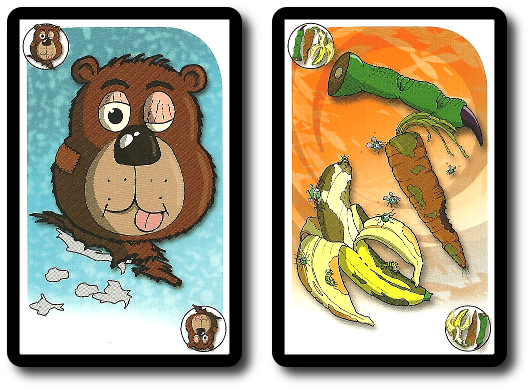
Second, place the 5 Monster Rage cards face-up next to the Recipe cards.
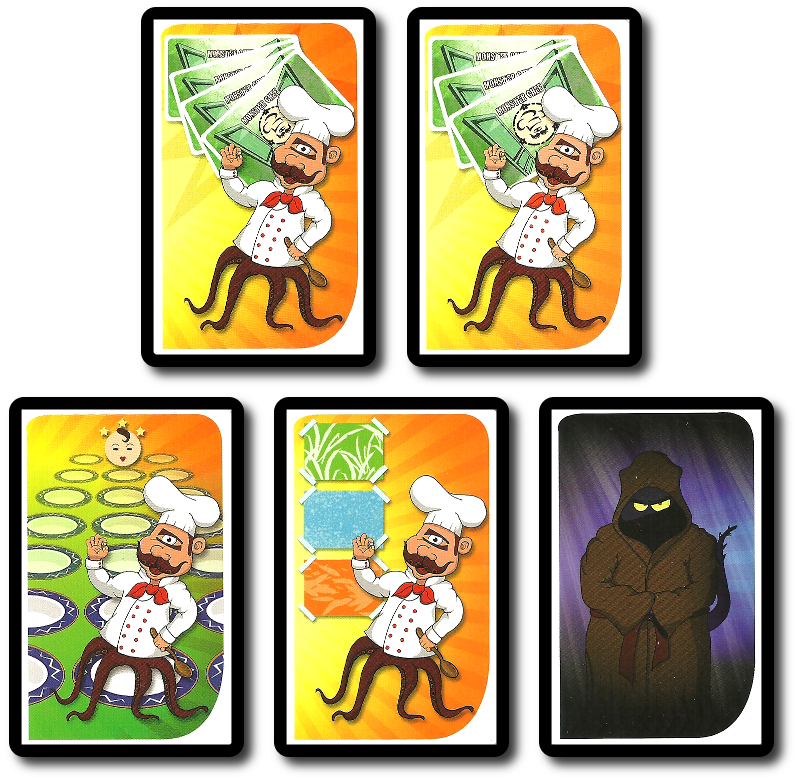
Third, determine as a group how long a game should be played. If the group wants to play a short game, put 1 Table card face-up in the middle of the playing area, for a medium length game put 2 Table cards in play, and for a long game use all 3 Table cards. Any Table cards not used should be returned to the game box.
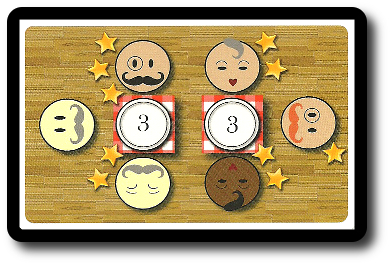
Fourth, give each player 15 Serving tokens of the same color. These will be used during the game to mark various cards. Any Serving tokens not used should be returned to the game box.
That’s it for game set up. Determine who the first player will be and begin.
Too Many Monsters in the Kitchen
Monster Chef is played in rounds and turns. A typical game turn is summarized here. While the steps should be followed in sequential order, a player can also activate a Monster Rage card. This is a one time bonus and can be done at anytime during the active player’s turn. The active player announces they are using a Monster Rage and places 1 of their Serving tokens on the Monster Rage card used. The Monster Rage bonus abilities are as follows.
- “Look there! A Flying Monkey!” – Use this ability to select a basket full of 4 Ingredient cards and be the first player during the next round.
- “Hey, That’s My Basket!” – Use this ability to select a basket full of 3 Ingredient cards and be the first player during the next round.
- “Way to Cook!” – Use this ability to add a second Serving token to a completed recipe.
- “I’m a Star!” – Use this ability to change 1 Ingredient card to a special ingredient.
- “If I Haven’t’ Got It, Neither Have You!” – Use this ability to remove 1 Serving token from an opponent’s Recipe card they are still preparing.
Step 1: Split the Ingredients
At the start of every round, the 9 Ingredient cards are shuffled and split into “baskets”, which is just a fancy way of saying “piles”. The number of Ingredient cards split between the baskets is dependent on the number of players. This is only done once per round.
3-Player Game:
- First Basket: 3 face-down and 1 face-up Ingredient cards
- Second Basket: 2 face-down and 1 face-up Ingredient card
- Third Basket: 2 face-down Ingredient cards
4-Player Game:
- First Basket: 3 face-down and 1 face-up Ingredient card
- Second Basket: 2 face-down and 1 face-up Ingredient card
- Third Basket: 2 face-down and 1 face-up Ingredient card
- Fourth Basket: 2 face-down Ingredient cards
Step 2: Choose Recipe
The active player now selects a Recipe card but only if they do not currently have one. Only those that are face-up in a row can be selected from. Once a Recipe card is selected and taken, a new Recipe card is drawn and placed in the row. When a Recipe card is selected and taken, the player places it directly in front of them, face-up.
Step 3: Choose Ingredient Basket
The active player now selects a basket. The majority of the baskets will have 1 Ingredient card showing, challenging the player to determine if it’s better to select a basket with a known Ingredient that they need or to take a risk and select a basket with unknown Ingredients. If there is only 1 basket left, the choice is obvious.
If a player selects a basket that contains only 2 Ingredient cards, they will be the first player in the next round.
Step 4: Use Ingredient on Recipes in the Kitchen Area
The active player now has two choices and can only target those Recipes in the “Kitchen area” (located next to the Table cards).
They can play 2 Ingredient cards that match an existing Recipe card in the Kitchen area, but only if that Recipe card has 1 Serving token. If they do, the Ingredient cards are discarded and the player adds their own Serving token to the Recipe card, piggy-backing off of the completed Recipe!
Or they can use 2 Ingredients on a Recipe card owned by an opponent that is currently in the Kitchen area. This will remove 1 Serving token on the opponent’s Recipe card, but only if they do not match the Ingredient cards on the Recipe card and only if a second serving wasn’t added this turn. The active player can also ruin a Recipe card in the Kitchen area by removing the last Serving token.
Step 5: Serve Recipe
If the active player has a Recipe in the Kitchen area from the previous turn that wasn’t messed with by their opponents, they can take the Serving tokens and place them to the numbered spaces on the Table cards. The number indicates how many Serving tokens can be stacked on that space. The Recipe card is then placed face-down in front of the player.
When there are enough Servings tokens, the active player moves the Serving tokens to the spots in front of the restaurant patrons. Each has a number of Stars on them which indicate how many points they are worth. The order in which the Serving tokens are placed is determine by the order in which they were stacked. Only 1 patron can be served 1 dish during the game
Step 6: Use Ingredients on Incomplete Recipes
If the active player has 1 Ingredient card that matches a needed ingredient for their Recipe card, they show it to the table, discard it, and then place 1 Serving token on the matching ingredient, indicating it has been added.
Step 7: Move Completed Recipes to Kitchen Area
If the active player has completed a Recipe card, they remove all but 1 Serving token and place the Recipe card in the Kitchen area.
Step 8: Discard Ingredients
The last step the player takes on their turn is discarding any Ingredient cards they still have in their hand.
This ends the player’s turn. The next player in turn order sequence now goes by selecting their basket.
Closing the Kitchen
When all the patrons have been served, the game comes to an end. This means a player could end the game without completing all the steps on their turn.
Each player counts the number of Stars their Serving tokens are next to on the Table cards. Whichever player has the most Stars it declared the “Monster Chef” and wins the game.
Game Variants
Two game expansions are included in the base game that can be used. Each are summarized here.
Being a Monster Chef
During game set up, randomly deal to each player 1 Monster Chef card. Each Monster Chef has a mini-goal that the player can attempt to complete to earn more points
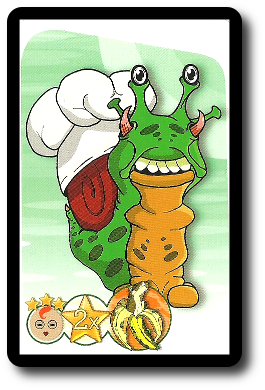
A Monster Reputation
During game set up, give each player 1 Reputation card. A Serving token is placed on the first spot on the Reputation card indicating the Monster Chef’s current reputation in the culinary world. Whenever a player collects the basket with 3 Ingredient cards, they roll the six-sided die and move the Serving token along the designated path. The player can refuse to do so, however, but this allows the player’s opponent’s to move their own Reputation tokens a number of spaces as indicated by the die roll. If by some chance all the player’s opponent’s refuse to move their Serving token, the active player must move their Serving token, regardless of how they feel about it.
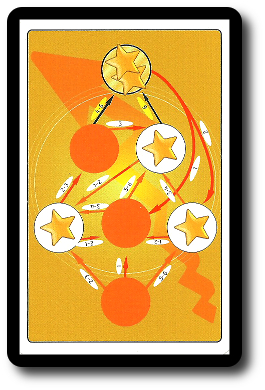
To learn more about Monster Chef, visit the game’s website.
Final Word
The Child Geeks really liked the Ingredient cards, finding the idea of cooking with yucky and broken things to be very interesting. According to one Child Geek, “This is exactly how I would expect a monster to cook. Using a ripped off stuffed animal’s head is just so evil!” Even more entertaining than the ingredients was the completion of the dish and serving it. As one Child Geek put it, “It’s not enough to be the first out of the kitchen. You have to serve it to the right people, too.” All the Child Geeks found Monster Chef to be a fast game full of fun and oftentimes interesting decisions. While the heat in the kitchen certainly became unpleasant at times, the Child Geeks never felt burned.
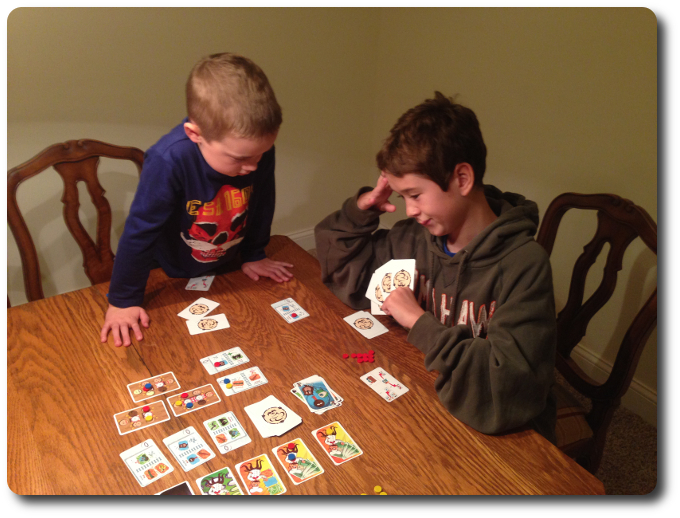
While my oldest son considers his options, his younger brother quietly whispers, “Hurry up!”
The Parent Geeks were pleased with the game, but the more advanced players found the game play to be too limiting at times. According to one such Parent Geek, “I don’t much care for the fact that I am forced to only work on one Recipe card at a time. I would rather multi-task.” Another Parent Geek said, “I would have preferred the ability to keep Ingredient cards after your turn is over. Right now I’m always given random cards that may or may not really help me.” While these limits were mentioned again and again, the Parent Geeks didn’t believe they reduced the game’s level of fun. They enjoyed playing it with their peers and with their Child Geeks, finding Monster Chef to be an entertaining game that had all the right ingredients for the family gaming table.
The Gamer Geeks did not care for Monster Chef, finding it to be a game that lacked meaningful strategy, tactics, and depth of play. They also found the Monster Rage abilities to be insignificant and the random card hands each turn to be intolerable. According to one such Gamer Geek, “How am I expected to play the game in a strategic fashion if I am always dealt random cards? Oh, I guess I can’t.” Another Gamer Geek said, “This game just isn’t cooking for me. Each hand is something random, but I do like how we can piggy back off of other players.” When the dishes were cleaned and the kitchen closed, the Gamer Geeks all agreed to never play Monster Chef again.
Monster Chef is a game that is one part resource collecting and one part timing. You have to get the right Ingredient cards to complete your Recipe card. Once you do, you have to get it to the table and serve it to the right folks to earn the most stars. The game is more than just playing cards as a result, but at no time does it feel like a game of great depth. It’s all very fluid and the steps a player takes is more or less completely on rails. This reduces confusion, but it also removes the player’s ability to be tactical.
For many of our players, the game’s lack of depth and tactical play wasn’t that big of a deal. The Child Geeks very much enjoyed themselves and the Parent Geeks did, too, although the more advanced Parent Geeks did find the game to be a bit shallow at times. The Gamer Geeks were the least impressed, but then again, they usually are. Monster Chef lacked just enough to be seen as coming up too short to be of any interest to the gaming elitists.
As for me, I found the game to be enjoyable and forgettable. I liked how it played, but nothing about the game play really surprised or delighted. The game certainly plays well enough and can be fun, but it lacks certain qualities that made me want to go play it again. I believe this is mostly due to that fact that you can always see what’s coming and the inability to do much about it. Still, the game did have its moments and it was fun to play with the Child Geeks. Especially when a few of them left the table to go find their chef hats.
On a personal note, I highly suggest you download and print the online version of the game rules to save your eyes and sanity. The font size used for the game rules available in the box were too small for all the adults to read comfortably, but none of the Child Geeks had any problems.
If you enjoy games about cooking and competing with others, then Monster Chef is a game you should play. While it might lack complexity and rich game play, it should please the palate of any gamer who is looking to take a bite of a casual card game.
This game was given to Father Geek as a review copy. Father Geek was not paid, bribed, wined, dined, or threatened in vain hopes of influencing this review. Such is the statuesque and legendary integrity of Father Geek.



